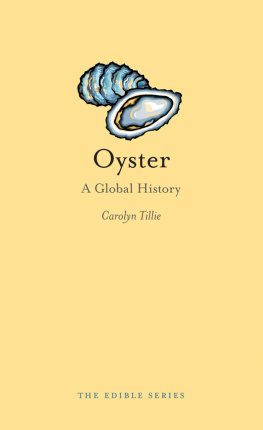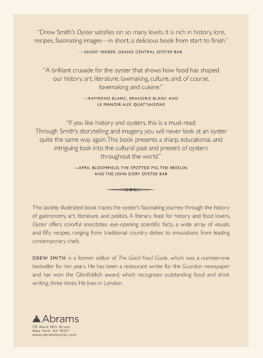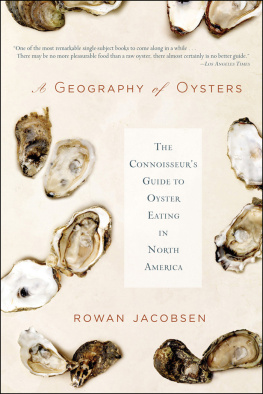


CONTENTS



INTRODUCTION
How I Learned To Start Giving a Shuck and Love the Oyster

He was a bold man that first ate an oyster.
Jonathan Swift

Close your eyes. Go ahead. Its OK. Now imagine youre sitting oceanside, a cool summer breeze drifting in off the waves. Subtle notes of salt and sweet seaweed waft into your nose. Goosebumps roll over your skin as you feel the sun hide behind a band of cumulus clouds.
This is how it feels to eat an oyster. In the culinary world, its hard to match such a pure, simple experience as looking at an oyster, holding it, and putting it in your mouth. These intriguing, delicious morsels represent the raw ocean incarnate.
In the past decade, a craft oyster trend has swept the East and West coasts. But take a close look and youll see oysters on menus almost everywhere. From the most highly rated restaurant to the greasy dive down the street, many different places are teasing customers into their establishments with the promise of bliss on the half-shell. You may even see vendors offering up oysters as youre on your Sunday afternoon stroll through townon the cobblestone streets of Fells Point in Baltimore, for instance, or in the bustling food fairs in Brooklyn, or along the coastline of Lilliwaup, Washington, and everywhere in betweenjust as they did in early seaside America.

According to restaurant-industry research by DataSsential, at the end of 2014, oysters appeared on 9.6 percent of all menus nationwide, a 15.7-percent increase from 2010. Fine-dining restaurants saw a 40 percent increase of oysters on their menus. Raw oysters can sell for $3 or more apiece these days. The premium price is not arbitrary. Crafting the oyster is an art. Its form and essence are the work of the watchful eyes and caring hands that raised and harvested it.
This boom of craft oysters is on par with the tidal-wave popularity of other recent food and beverage trends. In the same way that craft beer seeded the idea that microbrews werent just for experimenting at home, but could appeal to discerning palates at bar taps and in bottles across the nation, crafted oysters have gone from being a specialized coastal or high-end food to appearing on iced trays across the country. Similarly, the wine industry went through the move from commodity to specific branding a few decades ago. More recently, coffee has joined the craft movement and hot sauce has entered the fray.
Kent Messer, a researcher from the University of Delaware, made the comparison with coffee in a three-year study of the oyster industry: Recall the history of coffee in the U.S. It used to be a commoditya couple of big companies put coffee into a big blue or red can that contained coffee from all over the world that was mixed together and sold at a low price. Now you have many coffee companies and they will sell you coffee from a specific location. It could be Sumatra, Costa Rica, or even specific farms in Mexico. These coffees are sold at a higher price.
The same thing is happening with oysters. The nutritional and health benefits alone are fantastic; oysters provide a nutrient-packed low-calorie food in a small package. Eating a few oysters every day offers the recommended daily allowances of calcium, copper, iodine, iron, magnesium, manganese, phosphorus, and zinc. Omega-3 fatty acids abound for additional goodness. Foodies have flocked not only to the diversity of oyster types and their associated flavors, but also to the environmental ethos behind their cultivation.
Oysters are extremely sustainable. They dont need additional food sources beyond whats already in the water. All the time theyre in the water, theyre also cleaning it. They may seem like just two shells with a tasty morsel inside, but they are actually essential cogs in marine aquaculture. Get a load of oysters together, and the reefs they form not only filter water and provide nutrients for a whole host of aquatic life, but they help naturally protect coastlines from storm surges. Talk about a perfect food.
Oyster farmers recognize this high value, but educating the public is a key goal of the industry, both for growth and for future sustainability. The more people know of the benefits of oysters, the more they eat, and the more the industry thrives. As the saying goes, A rising tide floats all boats. Cheers to that.
Crucially, its no longer just about the word oysters on a menu. Take a glimpse at the offerings on raw bar menus today and youre bound to do a double take at catchy names such as Widows Hole, Holy Grail, Lady Chatterley, Little Bitches, Wicked Pissah, Effing Oysters, Murder Point, and a plethora of other creative and clever monikers. Eaters can now craft their own artisanal half-shell adventure with offerings from around the country. A few years back, it would be common to order a few bland oysters and think nothing of it. An unmemorable experience. An oyster was an oyster. But todays oysters are crafted around a kaleidoscope of flavor, as the subtle notes of the local waters balance the flavorful meats. Its like discovering an ultra-hopped-up IPA beer, an earthy Malbec wine, or a bold, robust coffee. Once you find an oyster that calls out to your taste buds, your senses are awakened and you keep coming back for more.
For a long time, oysters, to me, were just that: oysters. Ive always considered myself an adventurous eater and enjoyed oysters on occasion. I knew the basic types of oysters out thereEast, West, Gulfand I knew the general flavor differences between them. But that all changed when I began to discover the phenomenal regional diversity of oysters.
It started with a cross-country trip. After living in New York City for well over a decade, I needed a reset from the daily grind, and I ended up on the road solo for six months, exploring the amazing landscape of the United States. And what I discovered was that coastal cities, towns, and villages offered bivalves from places and with names Ive never heard of, often hyperlocal. Eating Norumbegas on the seaweed-strewn seaside in Maine, being mesmerized by the skills of the shuckers at Acme Oyster House in New Orleans, or gazing at foggy San Francisco Bay while downing a dozen (or two) West Coast delights at Hog Island Oyster Company, I was struck by one thing: Everywhere I went, there were phenomenal oysters. Once that shell of interest was opened, it was hard not to dive in.
In talking to servers, shuckers, restaurant owners, and oyster farmers around the country, I not only learned about the intrinsic nuances of flavor that make each oyster distinct, but also the methods used to raise and harvest them, the amazing hard work that the farmers put into them, and their stories. Suddenly, I wanted to know as much as I could about these bivalvesas well as tasting as many as I could!
Next page















